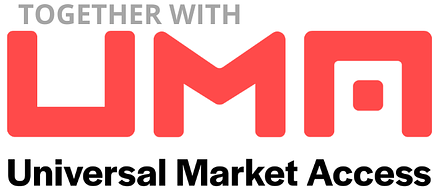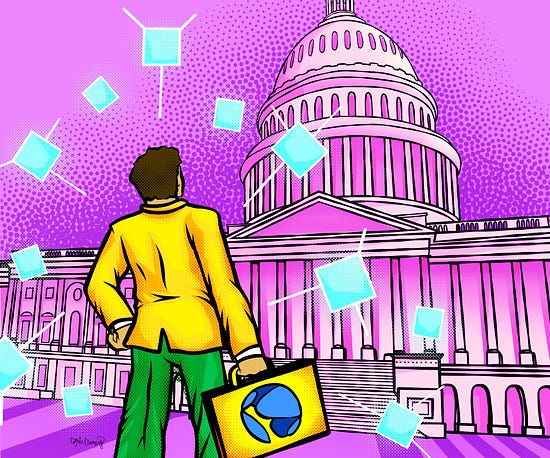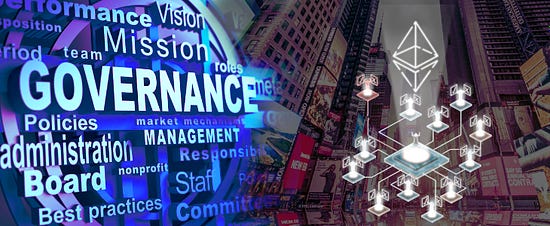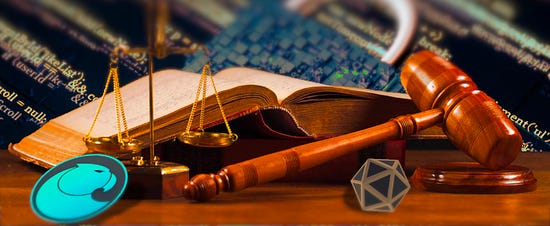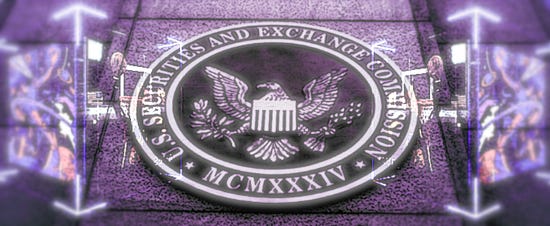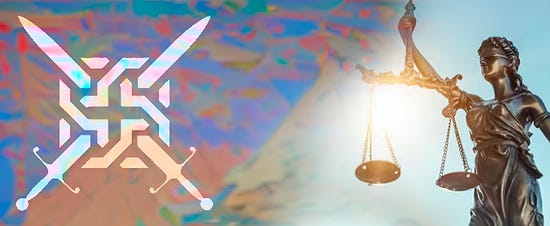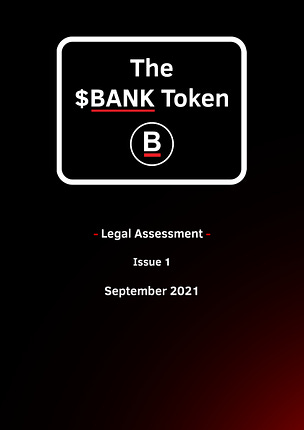Defending the Crypto Space | Decentralized Law #2 | December 2021
Defending the Crypto Space | Decentralized Law #2 | December 2021BanklessDAO Monthly Legal NewsletterDear Crypto-Legal Observers, In most areas of practice, lawyers are laser-focused on protecting their clients’ interests within the narrow scope of their engagement. In contrast, lawyers working with blockchain projects must view their efforts through a much broader prism. The current absence of legal certainty within the blockchain industry requires that lawyers continually stay informed about ongoing regulatory developments, particularly in relation to emerging legislation and third-party actions. On top of all this, most crypto-lawyers seem to be involved in a common effort: defending the crypto space! Defense of the crypto space is a necessary pursuit, with the future of the industry in jeopardy due to a widespread lack of understanding by lawmakers. The very real risk is that heavy-handed regulation will hamper further development and deployment of blockchain-based innovations, curtailing the industry’s potential for political, economic, and social disruption. How can lawyers best protect the crypto space? Lawyers should think of themselves as both students and educators. Working with cutting-edge clients in the crypto space gives lawyers a privileged position from which to develop a comprehensive understanding of the blockchain industry’s potential to address a wide array of societal concerns, from remittances to open elections to cleaner air. With this deep understanding, lawyers should then work to educate legislators, ensuring they understand the importance of explicit and sensible regulation. Alongside crypto-lawyers, the first wave of crypto-native executives are working hard to persuade legislators to draft thoughtful laws that will lead to clear regulatory frameworks. This persuasive effort was on display at a recent U.S. House Committee on Financial Services hearing, where crypto CEOs had the opportunity to offer testimony concerning their industry and the need for more certainty from Congress.  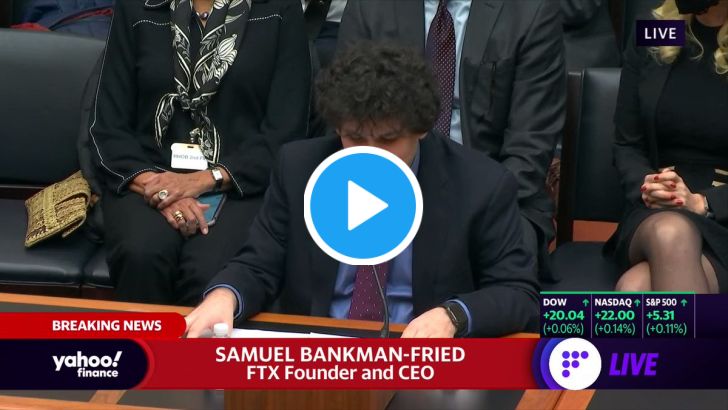  Crypto CEOs work shoulder-to-shoulder with legal advisors—particularly at major protocols with significant political and legal exposure. These projects need an experienced and influential general counsel capable of dealing with the myriad political and legal matters inherent to the borderless nature of the cryptoverse. This issue of Decentralized Law features an interview with Marc Goldich, General Counsel of Terraform Labs. Marc shares insights gained while working with those in the upper echelons of the crypto space. Although this newsletter may help to familiarize readers with the legal implications arising from blockchain technology, the contents of Decentralized Law are not legal advice. This newsletter is intended only as general information. Writers’ opinions are their own; therefore, nothing in this newsletter constitutes or should be considered legal advice. For that, contact a legal expert in your jurisdiction. BanklessDAO Legal Guild (eaglelex, lion, hirokennelly.eth, taxpanda, Terumask, drllau, Trewkat, Cheetah, MDLawyer, B(3,A)Rhunter) This is the official legal newsletter of BanklessDAO. You are subscribed to this newsletter because you were a Premium Member of the Bankless Newsletter as of May 1, 2021. To unsubscribe, edit your settings. 🎙 InterviewDefending Crypto Projects with Marc Goldich
Firstly, I must start by saying, thank you for reaching out. I thoroughly enjoy the Bankless newsletter and am happy to be in the company of the other subjects who have participated in a Decentralized Law interview. Secondly, this is my caveat for everything I say here: I am not one to give (or take) career advice, as I believe survival bias can skew outcomes and that no two paths or circumstances are ever the same, so readers should understand my story is just that; one man’s story. That said, my journey to crypto law is unique so hopefully your readers will find it interesting. I began my career at the international law firm of Reed Smith, where I spent over a decade representing some of the largest companies in the world in complex litigation and regulatory matters. From representing companies in high-stakes regulatory enforcement actions to bet-the-business international disputes, I was charged with advising clients on the best course of action and representing their interests in court. I found this work to be mostly engaging and fun. Although life in Biglaw is not easy and there isn’t much job satisfaction in general, I managed the better part of a decade happily serving clients and working with a small group of trusted colleagues and friends in an otherwise traditional law firm setting. Ultimately, however, the work became monotonous and mundane, and I realized that being a part of that highly bureaucratic world was not sustainable for me. I sought a greater purpose and more autonomy to be entrepreneurial.
After 11 years, I left Reed Smith to manage a class action and whistleblower practice at a Philadelphia plaintiffs’ firm with a national presence. I then opened my own class action and whistleblower law firm with Noah Axler (currently of Anderson Kill), a frequent opposing counsel for whom I had a great deal of respect from my time defending financial institutions in class action lawsuits (brought by his clients). We mostly specialized in class action and whistleblower cases, litigated our cases in courts all around the country, and recovered tens of millions of dollars for clients nationwide. It was fun and meaningful work, but the class action business is very mature and slow moving. In 2017, to diversify our interests, we started getting into the fast moving and intellectually stimulating crypto industry and began exploring the intersection of blockchain technology and litigation finance. This resulted in our founding in 2018 of LawCoin, the parent of the blockchain-based litigation investment platform, Dejure.io. We shortly thereafter became a ConsenSys portfolio company and it was our participation in the ConsenSys Tachyon accelerator program and our work on that project (including completing the first-ever tokenized litigation finance investment) that really thrust me full speed into crypto. In parallel with all of that and with litigating our ongoing legacy cases, I continued to dive deeper into the space, growing Axler Goldich’s crypto law practice and engaging in crypto-law community-building and lively discourse with other crypto lawyers at the forefront of the industry. Having swallowed the red pill in its entirety, and after nearly two decades representing clients in all types of industries, I recently retired from private practice to become General Counsel of Terraform Labs.
You will never be the smartest person in the room. Do not overcompensate once you inevitably realize this truth. I say this in jest but, seriously, there are true giga-brains working in this industry. This means that you must understand their needs, speak their language, and offer practical and pragmatic legal counsel while, at the same time, not let them pull the wool over your eyes or skip over important details for want of better understanding of the tech. Crypto lawyers should also recognize that they are often only going to be one input in a decision tree. This is still a nascent industry with a lot of uncertainty, legal and otherwise. As lawyers, we do our best to present our clients with an analysis of risks and counsel them about the likelihood of negative consequences from taking any course of action by weighing the remoteness and severity of said risks. The difficulty in crypto is that the technology does not fit neatly into the legacy regulatory framework, and—notwithstanding oversimplification and misunderstandings of the tech—this is why lawyers who understand both the tech and the industry serve an important and valuable role.
As per above, if you find you are the smartest person in the room, don’t take those clients. Jokes aside, when I was in private practice, the biggest red flags were probably the following: (1) projects hopping from lawyer to lawyer seeking an answer they want as opposed to the answer or advice they are being given; and (2) projects that have no real reason to utilize blockchain technology or tokens. Sometimes projects find cute ways to say, “how do I do something illegal but make it look legal.” You don’t want those engagements. That said, by and large, founders in this space are good actors looking to do interesting things with exciting technology.
Undeniably, yes. By its very nature, this nascent technology intersects with global jurisprudence. Blockchain technology touches the contract, intellectual property, regulatory, and antitrust laws of jurisdictions all around the world. Indeed, the vast majority of blockchain transactions take place in an international context. Given the globalized nature of crypto and digital asset trading in general, there are a great number of governmental bodies seeking to exert jurisdiction over the space—often with drastically different views and strategies—and having competent counsel with an understanding of each jurisdiction’s laws and regulations is vital to designing a thoughtful, and compliant, path forward. 🏛 RegulationThe European MiCA Regulation: A Friendly Model? - Part IAuthor: eaglelex
This article presents a brief evaluation of the Proposal for a Regulation of the European Parliament and of the Council on Markets in Crypto-assets (COM(2020) 593 final) (hereafter, “MiCA”). Part I, presented herein, will provide a general overview of MiCA and focus on the nature of so-called “utility tokens.” When assessing the MiCA regulation, it is necessary to consider the aims of the European Union (EU). The first and foremost aim of the EU is the creation of a single internal market, where businesses are free to move and to enter into relationships that are governed by a common set of applicable laws. The digital revolution has brought an additional, ambitious aim: that of building a future-ready economy that works for the people. In this regard, the most innovative elements of European law are encompassed in the recent “digital finance package.” In the words of the European Commission, the package aims to ensure that “the EU embraces the digital revolution and drives it with innovative European firms in the lead, making the benefits of digital finance available to European consumers and businesses.” Given that the blockchain industry is global in nature, the risk is that the MiCA initiative is ultimately too narrow. MiCA’s scope of application is merely regional, with rules, in principle, devoted to EU-located businesses. The ultimate measure of MiCA’s success will be the model’s adoption by other jurisdictions. These regulations must set high qualitative standards but also be able to work as a benchmark for non-European jurisdictions. There is precedent for this: the European General Data Protection Regulation (GDPR), a European-centric law concerning online consumer privacy that has found favor in other jurisdictions. One aim of MiCA is the protection of investors and consumers, but it is crucial to avoid creating rules which are potentially detrimental for European businesses. The challenge MiCA must address is the need to foster innovation and attract investments in technology while ensuring that blockchain-based businesses don’t exit Europe in favor of friendlier jurisdictions. MiCA covers 5 different areas (Art. 1):
According to the Commission, the proposed text seeks to “provide legal certainty for crypto-assets not covered by existing European financial services legislation and establish uniform rules for crypto-asset service providers and issuers at European level.” The scope of application of MiCA should therefore be residual in nature, as it does not apply to cryptoassets that qualify as financial instruments (Art. 2). This is very good news from the perspective of U.S. lawyers accustomed to dealing with the wide scope of the Howey Test in matters related to cryptoassets. Finally, we have proof there is a space in which securities laws do not apply—where cryptoassets are just cryptoassets! Yet the question remains: which kinds of tokens are not considered a security? MiCA devotes many rules to two types of tokens:
Asset-referenced tokens are a broad category of stablecoins and other types of commodity tokens, such as DAI. Electronic money tokens, conversely, are tokens that are pegged to a single currency, e.g. USDC or USDT. Tokens which are not financial instruments are less clearly defined by MiCA. The only clear definition concerns the so-called “utility token,” defined as a type of cryptoasset “which is intended to provide digital access to a good or service, available on the [distributed ledger], and is only accepted by the issuer of that token.” The attractiveness of the MiCA proposal largely concerns utility tokens, which is why its framework should be carefully assessed. Such “utility tokens” have non-financial purposes related to the operation of a digital platform and digital services and should be considered as a specific type of cryptoasset. Some scholars argue that utility tokens also provide holders with governance rights in the issuing organization, such as the right to vote for updates in the functional structure, and otherwise shape the future of the organization. A utility token which meets one of these definitions is not usually considered a traditional security or financial product; its aim is not to create future cash flows but rather to enable interaction with a blockchain-based ecosystem. The most prominent example of a utility token is Ether. Besides being a cryptocurrency (Ether tokens can be used to directly transfer value), the token also enables functionality on Ethereum’s decentralized computing and smart contract platform. Users can pay transaction fees (gas) with Ether and interact with other tokens on the network using Ether. Another example which is often mentioned is “Filecoin,” which functions as a reward for users providing storage space to the network and can be spent to store and retrieve data thereon. Of course, even tokens that function as utility tokens will typically have an investment component, as these tokens can be traded on centralized or decentralized exchanges. Therefore, most utility tokens are a hybrid of finance and function. From a different perspective, pure utility tokens (when abstracting them from any investment component they may have) are not comparable with shares in companies, partnerships, or other entities. Utility tokens do not confer ownership in an underlying company, but to a certain extent, they often grant membership in the blockchain-based platform. Unlike shares in a corporation, the aim of the membership is not to generate future cash flow but instead to permit interactions with the blockchain. For instance, a shareholder of a U.S. listed company does not have any conferred right to consume the product created by the company, whereas this is exactly the function of a utility token. MiCA does not address the problem of the dual nature of the utility token. The issue has been discussed in literature but is not directly tackled in the proposal. It is argued that if utility tokens encompass significant investment components, they could be subject to securities regulations. Utility tokens are subject to disclosure duties, which are encompassed in Title II of MiCA, while asset-referenced tokens and e-money tokens are subject to a licensing and authorization requirement, as well as certain operating conditions. Art. 4 MiCA does contain some issuer requirements. The issuer should be a legal entity residing inside or outside of the European Economic Area. For issuers established outside the European Union, jurisdiction lies with the competent authority of the Member State, either where the cryptoassets will be offered or where the admission to trade on a platform is initiated. The issuer in these cases must draft a “crypto-asset white paper” that complies with Art. 5 MiCA and give notice of that white paper to the competent authority. Moreover, the issuer must ensure that funds provided to the cryptoasset offering are safeguarded and segregated. Additionally, the issuer must comply with basic conduct of business rules laid down in Art. 13 MiCA. Finally, any marketing materials must be clearly marked as such and refer to the white paper. The MiCA disclosure, conduct, and liability rules relating to the white paper are similar to the financial instruments prospectus requirements set forth by European law. The aim of these rules is to address the inadequate disclosures, misrepresentations, and fraud sometimes observed in certain ICOs. In return for MiCA compliance, white paper issuers benefit from a “European Passport” concerning the issuance of cryptoassets (Art. 10 MiCA). The Passport works as proof of compliance and should foster a safe single European market for the token industry. A significant difference between the financial instruments prospectus and the white paper is that the latter is not subject to preliminary approval by supervisory authorities. The white paper is required to be posted with the competent national financial authority twenty days prior to the offering and the competent authority has the right to intervene before and after the offer is under way. Competent authorities are therefore allowed to carry out supervisory functions before and after the publication of the white paper. The European Commission justifies this rather unusual approach (compared to the rules on financial instruments) by pointing out the need to avoid an excessive burden upon competent authorities. On the basis of these first impressions of MiCA, it is possible to discern strengths and weaknesses in the overall approach to the legal classification of tokens. MiCA’s approach to the regulation of tokens which are not considered financial instruments is a strength. Further, providing a clear definition of a utility token can advance technological innovation in many different sectors. Nevertheless, uncertainties remain regarding this regulatory approach. The category of cryptoassets which are not financial instruments, asset-referenced tokens, or electronic money tokens is not clearly defined, but only addressed as a residual catch-all category. In this framework, the categories of asset-referenced tokens and electronic money tokens do not adequately represent what the industry is actually offering. It would have been better to adopt three distinct categories—payment, investment, and utility tokens. Moreover, it is not clear which of the existing market venue rules will apply to circulation of tokenized financial instruments. Part 2 of this article will appear in the next issue of Decentralized Law. Note to readers: Crypto-asset is hyphenated in the above article only where the text is taken directly from the proposed MiCA legislation. All other usage reflects the Decentralized Law style guide. 🌏 DAO Global Entities Monthly SeriesCan Corporate Governance Issues Be Solved By DAOs?Author: Cheetah
Traditional corporations have proven themselves as effective vehicles for organizing businesses, particularly in relation to aspects such as governance and legal structures. Corporations are governed through a legal framework that protects the interests of its owners, managers, and shareholders. Corporate laws mandate horizontal fairness via rules on participation such as quorum, information rights, and tag-along triggers. Corporations rely on vertical agency constructs to govern themselves, whereby trust is placed in agents such as the Board of Directors (BoD) or key managerial personnel to make decisions in the shareholders’ interests. This trust, because it's centralized, may give rise to misbehavior or opportunistic conduct (e.g. self-dealing). The placement of such trust is often justified using the argument that shareholder value-maximization is easier with centralized decision making. Jurisdictions try to mitigate the tendency towards self-dealing by detailing norms for shareholder protection, the role of the board, and by imposing rigorous transparency and disclosure requirements. However, problems are pervasive and persistent and a true balance between the interests of all parties is rarely achieved. Enter Blockchain and DAOsBlockchain technology offers a unique solution to the pitfalls associated with traditional corporate governance: centralized concentration of power, hierarchical decision-making, and human fallibility. Blockchain-based governance reduces or eliminates the need for trusted intermediaries—replacing them with member-managed code. Code is law in blockchain, after all (a position not without controversy!). The birth of smart contracts, which are essentially self-executing computer programs, has given rise to a new type of organization—the decentralized autonomous organization, or DAO. A DAO is a group of individuals, typically organized around a common mission, who organize themselves and build consensus that ultimately manifests with on-chain governance and financial transactions. In a DAO, the chances of financial misbehavior and collusion are significantly lowered as matters are governed by code. For instance, financial transactions are typically on-chain and transparent to all, leaving little room for fraudulent activities. In a DAO, there is no BoD, suite of executives, or other nodal authorities that dictate the decision-making. DAOs use technology to create flatter organizational structures. DAOs typically issue governance tokens to facilitate decision making, and these token holders vote on projects and proposals in a democratic process that is truly transparent. The chief advantage of a DAO, therefore, is that the uncertain human element is replaced with objective, self-executing code that is independent of personal trust. There are other advantages to DAOs as well. First, they are flexible because the flow of information is optimized through dynamic feedback effects. Consequently, DAOs are more attack-resistant and can grow rapidly. Second, they can be much more efficient in relaying and relying on local knowledge and circumstances because information is less siloed. The distribution of power confers more flexibility and autonomy to the members of the DAO and offers enhanced options for a structure with interacting domains of expertise. In contrast to the typical corporate structure, DAOs are downright revolutionary organizations. Pitfalls of DAO GovernanceThis sounds too good to be true, right? What’s the catch? To start with, aligning incentives with governance is an ongoing problem across all structures, and DAOs are no exception. Voter apathy is universal, it seems. For members to maximize their utility for the organization while aiding the mission of the DAO, proper incentivization is necessary. In the absence of that, opportunistic actors will sooner or later game the governance design. Further, there is the problem of concentration of active voting power. In any given DAO, there are those who hold a substantial share of the native-governance tokens. As has been the case with many decentralized protocols, such outsized holdings can create unfavorable outcomes. This situation is aggravated by the incentive problem which causes low voting participation on the chain. Lastly, if the users of the network are non-token holders, there might be a misalignment of interests with the DAO. Furthermore, the lack of default rules regarding DAOs creates unintended gaps within the smart contract-enabled governance frameworks. Corporate laws across jurisdictions have mandatory or default rules which act as buffers in uncertain and novel situations. Because of these default rules, contracting parties are spared from accounting for every single eventuality in their relationship. In the case of DAOs, although model governance rules have been written, no jurisdiction has yet enacted them in any way comparable to model rules for traditional business entities. Some argue that at least in the case of DAOs, such rules are unlikely to provide any guidance at all. It is possible for the founders of a DAO to opt in to an existing legal entity framework, but that is hindered by the current technology-averse legal infrastructure which relies on natural language rather than code. But choosing to remain outside of a legal wrapper exposes DAO members to unlimited liability. Extant corporate law would seem to characterize DAOs as a general partnership where each partner, or in this case DAO member, would be jointly and severally liable for the debts and liabilities of the DAO. The newly enacted Wyoming law offers a solution to the liability issue by layering limited smart contract governance provisions atop of a Limited Liability Company framework, but legal uncertainty remains in most other jurisdictions. The legal and governance issues faced by DAOs will be remedied in time. DAOs may adopt dynamic governance where regulatory supplements plug gaps in the code. Further, DAO members could be incentivized with indirect monetary gain with innovative governance models, such as those involving staking. Other on-chain governance models (e.g. Tezos, Dash, Cardano, Maker) and reputation-based governance solutions may also be explored. Reforming Corporate Governance?Will traditional companies adopt some of the internal practices of DAOs? DAO members are subject to a different agency relationship as they are generally free of a central authority or corporate hierarchies. DAO members work in a dynamic set of personal relationships that are self-organizing. While DAOs don’t normally rely on external incentives such as regular wages or common-law duties of good faith, a rationalist argument is that DAO members often unify to optimize the DAO to increase the value of its governance token. Quite simply, if an optimization offers value to the token holders, it will be pursued. These are crucial breakaways from our current organizational structures which are centralized and burdened with onerous fiduciary duties. Line up the incentives and the need for fiduciary oversight decreases. Only time will tell whether DAOs replace traditional corporations. However, one thing is certain: DAOs are testing the effectiveness of these corporations’ traditional structures and the law will need to keep pace. ⚖ DevelopmentsDecentralized Courts: A Legitimate Solution?Author: lion917
Blockchains, cryptocurrencies, and NFTs continue to make headlines because of the recent crackdown in China and the proposed legislation in India and the United States. A commonly-held view is that governments dislike cryptocurrencies for taking away their economic sovereignty. However, this is a somewhat limited view. Cryptocurrencies also challenge the basic norms of governance, as they incentivize new systems of coordination and consensus. The recent creation of decentralized courts—an automated dispute resolution mechanism that allows outcomes to be enforced through smart contracts on a blockchain, will dilute but not entirely eradicate the government’s control over its judicial system. In May 2021, a Mexican Civil Court upheld and enforced an arbitration award which was obtained through proceedings governed by the popular blockchain dispute resolution tool Kleros. The real estate dispute was submitted to Kleros in October 2020, and within a month three adjudicators unanimously decided the outcome. The arbitrator affirmed their decision and the winning party’s motion for enforcement was upheld by the Mexican court without reservation, demonstrating that verdicts rendered in decentralized courts can be recognized by traditional legal systems. But for these courts to meet their full potential, they must become a self-sufficient legal system which can function without needing subsequent ratification. Kleros was one of the first open-source and opt-in dispute resolution systems built on the Ethereum blockchain. Kleros uses crowdsourcing and incentivizes participants using principles of game theory to adjudicate disputes efficiently, equitably, and reliably. When a dispute is submitted by parties to Kleros, a panel of jurors is selected randomly from a larger juror pool. To be eligible, jurors must have staked Pinakion (PNK), Kleros’ native token. Each juror assesses the evidence submitted and registers a non-public vote. If a juror’s vote is in consensus with the majority vote, the juror keeps the staked tokens; if in the minority, the juror forfeits their tokens. Additionally, those jurors who voted with the majority are rewarded with the forfeited tokens and the tokens that are charged as arbitration fees. This practice creates economic incentives for jurors, encouraging them to seek consensus. Jur and Aragon Court are two similar blockchain-based dispute resolution mechanisms that provide decentralized adjudication. As with Kleros, in Aragon Court the amount of tokens staked is directly proportional to the probability of being drawn as a juror. Malicious voting is discouraged because each juror knows that inconsistent voting will likely lead to the loss of staked tokens. Decentralized courts often have more than two levels of appeals, with the number of jurors increasing exponentially at each appellate stage. Thus, the cost of dispute resolution increases proportionally to the probability of multiple appeals. While most decentralized courts were designed to adjudicate real life disputes and escrow agreements, many leading decentralized courts are looking to revamp their systems to accommodate the rise of Decentralized Autonomous Organizations (DAOs). On their own, most decentralized courts don’t have a profitable revenue model and as such must co-exist with a broader service. For example, Aragon is a leading DAO tooling platform which offers dispute resolution services. The use of the staking model in decentralized courts, combined with the current reliance on the Ethereum blockchain, means this model is cost prohibitive for some due to excessive transaction fees. To keep decentralized courts accessible to all, an insurance-like product should be explored to offset the costs of decentralized adjudication by permitting parties to pay a small fee to a decentralized court or service at the time of drafting the dispute resolution clause in an agreement. In addition to high transaction costs, practical use cases are limited. The use of decentralized courts is limited to technologically savvy users. Since there are no particular eligibility requirements to become a juror, disputes with nuanced legal issues may not be resolved; decentralized courts are most effective when resolution of the dispute involves answering simple yes/no questions. In practice, use cases are limited to civil disputes, as it is unlikely that users will put their faith in these systems for resolving complex criminal and constitutional cases. In addition, sovereign governments will not readily concede their implied rights over constitutional and criminal proceedings. Although use cases are currently limited to commercial disputes where the parties can afford the transaction costs, it seems very likely that decentralized courts will grow alongside the DAOs and blockchain-based protocols they are most suited to serving. Questions of legislative and constitutional interpretation and the resolution of criminal proceedings will likely remain the sole province of the traditional court system for the foreseeable future. But as we are learning, the future can arrive faster than we think. NFTs: Securities? Freil vs. Dapper Labs
Author: Terumask In a few years, when we look back at the 2021 bull run, we will undoubtedly remember the hype about non-fungible tokens (NFTs). NFTs have found favor as an innovative solution for tracking digital asset ownership using the blockchain. But as with most innovations, NFTs have brought forward legal challenges. In May 2021, one of the first lawsuits involving NFTs was filed in the State of New York. NFT buyer Jeeun Friel sued Dapper Labs, the developer behind CryptoKitties, for selling an NFT collection known as NBA Top Shot Moments (NBA Top Shot) without complying with the Securities and Exchange Commission (SEC) guidelines and federal securities laws. The plaintiff alleged this failure to comply caused significant damages to retail investors lacking the technical and financial expertise to correctly assess the risk. NBA Top Shot offers Moment™ collectibles: NFTs which feature video footage and associated statistics for a particular highlight moment in an NBA player’s career. According to the NBA Top Shot website, more than 600,000 NBA fans own a collectible. Whether an offering is considered a security is determined by the Howey Test (SEC v. W.J. Howey Co). This test defines securities as (1) an investment of money (2) in a common enterprise (3) with a reasonable expectation of profits (4) to be derived from the efforts of others. In Friel v. Dapper Labs the plaintiff alleges that the Howey Test applies to the NBA Top Shot NFTs. In the case of NBA Top Shot, the NFTs are sold in packs or on their marketplace, leaving no doubt that the NFT purchase required an investment of money and therefore meets the first element of the Howey Test. When it comes to determining whether or not NFTs are an investment in a common enterprise, the lawsuit uses two arguments: (1) with digital assets, the common enterprise usually exists because “the fortunes of digital asset purchasers have been linked to each other or to the success of the promoter’s efforts” (SEC Framework); (2) in NBA Top Shot, Dapper Labs controls the enterprise and makes the decisions, linking the profits or losses of Dapper Labs with the profits or losses of NBA Top Shot owners. NFTs are unique and non-interchangeable, so it could be difficult to prove that individual value is dependent on the others in a collection. What may be easier to prove is the second argument for common enterprise: that there is a link between the profits and risks of Dapper Labs and those of NBA Top Shot owners. In this case, it could be argued that there is a direct link because Dapper Labs is able to set and collect a percentage fee on every transaction. The higher the selling price, the more income Dapper Labs receives. In this way, the fortunes of both parties are connected. This doesn’t mean that a common enterprise exists for every NFT. For example, in instances where an artist mints an NFT and sells it without assigning themselves the right to future royalties, their profits are only drawn from the initial sale and there is no ongoing financial relationship between the artist and NFT owners. To satisfy the third element of the Howey Test, which relates to the expectation of profits, the plaintiff claims that NBA Top Shot owners and Dapper Labs can generate profits from the capital appreciation of each asset, arising from market demand and facilitated by secondary markets where holders can resell their NBA Top Shot. It is true that some buyers purchase NFTs with the mere intention of owning them as a unique collectible, in the same way that people collect baseball cards or paintings. However, other purchasers are speculating that they can return a profit upon the resale of the NFT. Where ownership of an NFT includes royalty rights or where purchasers acquire NFTs subject to a hidden reveal, it should be straightforward to confirm the buyer’s expectation of profits. On NBA Top Shot, people can buy the packages without knowing which NBA Top Shots are inside, which could reinforce the idea of speculation. Finally, the last Howey Test requirement is that the expectation of profits should be based on the effort of others. On this point, the lawsuit alleges that: (1) Dapper Labs controls the Flow blockchain, which is essential for the existence of the NBA Top Shot; and (2) that they can make marketing decisions that increase NBA Top Shot hype, which would increase the demand. The key question here is: does the price change because of Dapper Labs’ market decisions or because of supply and demand in the market, and are these factors inextricably linked? Perhaps it is the latter, but because Dapper Labs operates a centralized platform and maintains control over the market, there is a demonstrable impact on the NBA Top Shot prices. Whether an NFT meets the definition of a security is far from clear-cut and should therefore be determined on a case-by-case basis. It will be very interesting to follow the outcomes of the Dapper Labs case and similar lawsuits to see how the courts decide on this issue. 👮♂️TaxationU.S. Tax Considerations and Questions Raised by ConstitutionDAOAuthor: taxpanda
For a few days in November, the cryptoverse and the real world collided when ConstitutionDAO bid for and nearly won an original copy of the United States Constitution. Having raised nearly 50 million USD in the span of one week, ConstitutionDAO had an on-chain war chest and became an early favorite to win the auction, which was hosted by Sotheby’s. ConstitutionDAO was outbid at the last second by a multi-billionaire investor and hedge fund CEO. According to Sotheby’s, the winning bid of 43.2 million USD broke the record for the highest price paid for a historical document sold at auction. ConstitutionDAO made history, but the fact remains that they lost the auction. Post auction, the core team was tasked with the administrative burden of working out what to do with the unused funds. After some deliberation over which direction to take the DAO, the core team decided to wind down the project and offer refunds to those who contributed. These refunds are available via Juicebox, the smart contract platform used for the initial fundraising. The ConstitutionDAO website provides two options for the refund: claiming ConstitutionDAO’s native-governance token, PEOPLE, or redeeming PEOPLE for ETH at the original purchase ratio of 1 ETH : 1 million PEOPLE, minus gas fees. As with many crypto-related projects, everything with ConstitutionDAO happened very quickly. Many legal and logistical questions remain as its affairs continue to wind down, including many tax-related questions. The ConstitutionDAO website clarifies that “ConstitutionDAO cannot and will not endorse any future plans for the token.” Additionally, admins in the ConstitutionDAO Discord server have since announced plans to launch a new “We the People” token for any future projects. Despite these statements, a secondary market formed for PEOPLE, and shortly after the auction many donors were able to make a profit from selling their PEOPLE on decentralized exchanges. For those who took advantage of the surge in value of PEOPLE, remember that those transactions are likely taxable short-term capital gains for U.S. tax purposes, based on the fair market value of ETH at the time those tokens were purchased and the fair market value of the property/cryptocurrency received when the tokens were later sold. To date, just over half of the total funds have been claimed as refunds, meaning that millions of dollars still sit in the smart contract. It’s possible that the more crypto-savvy participants are waiting to reclaim their funds, whether because of high gas fees or having already aped into new projects which have shifted their attention for the time being. However, a significant amount of the remaining funds are likely to be relatively small contributions (the median donation being about 200 USD) by non-crypto-native folks who are now finding that they might have to pay more in transaction fees than the amount they originally contributed. If you’re in the latter category, don’t be discouraged. You may still be able to take advantage of a loss for U.S. tax purposes, for example, by using the capital loss to offset capital gain (subject to those specific rules). Even if the amount of the contribution seems relatively small, the refund must actually be claimed in order to determine what the tax effect would be. Still, there’s no guarantee that all of the funds will be returned, and it appears that refunds not claimed will stay in the smart contract forever. Presumably, for example, someone could remember ten or fifteen years from now that they contributed ETH to ConstitutionDAO, go back to the ConstitutionDAO website, and claim their refund. I’ll admit that I don’t know the details about how the actual smart contract that ConstitutionDAO implemented with Juicebox is written, specifically the refund feature (I’m a TaxPanda, not a DevPanda), but I would be interested to know how much control over these non-refunded amounts the smart contract allows Juicebox, ConstitutionDAO, or both, to have. For example, is there any way that either ConstitutionDAO or Juicebox could decide in fifty years that anyone who would have ever claimed a refund had already done so, and donate the remaining amount to charity or a different project? Could ConstitutionDAO have somehow received the entire amount of the funds and distributed them back to contributors itself? Questions like these are mainly important in order to determine the tax effect on the organizers themselves, i.e., ConstitutionDAO and Juicebox. As a result, it’s even more important for anyone who is planning and developing projects with similar fundraising scale to keep these questions in mind and understand the implications of potential outcomes, from how the smart contract is written to what legal entity should be used. ConstitutionDAO formed an LLC and considered the possibility of becoming a 501(c)(3) tax-exempt organization for U.S. tax purposes.
Ultimately, ConstitutionDAO did not win the auction and critics jumped at the opportunity to label the attempt a complete failure. Despite the negative criticism and the remaining issues to be resolved, both crypto-savvy and non-crypto-native people can and should appreciate that there is a thick silver lining: ConstitutionDAO’s valiant effort was a win for the people in an area typically reserved for an elite few, shedding more public light on the power and potential of blockchain technology, cryptocurrency, and the crypto community.
It’s almost tax season and if you haven’t found a reliable crypto tax prep solution yet, TaxBit should definitely be on your list of potential crypto tax solutions. TaxBit connects all your cryptocurrency transactions across every exchange so that you can accurately file your taxes, manage your portfolio, and make tax-optimized trades. Visit TaxBit to start a free trial and use code “banklessdao” for 30% off any TaxBit plan! 🙏 Sponsor: UMA - Making financial markets universally accessible. DAO Better. 🌐 News and Selected Articles
Real Estate Has Gone MetaAuthor: Adam Clark Estes 🔑 Insights:
Capitol Hill Warms Up To CryptoAuthor: Andrew Chow 🔑 Insights:
Russia to Decide Between Blanket Crypto Ban and Legalizing Exchanges in 2022Author: Zhiyuan Sun 🔑 Insights:
On Crypto Bill, More Changes Likely, Government Goes Slow: 10 PointsAuthor: Sunil Prabhu 🔑 Insights:
Insuring Crypto: The Birth of Digital Asset InsuranceAuthor: Adam Zuckerman 🔑 Insights:
Regulating Libra: Will Legal and Regulatory Uncertainty Prevent the Launch of Facebook’s Cryptocurrency Project?Author: Amanda Simmons 🔑 Insights:
From NFTs to CBDCs, Crypto Must Tackle Compliance Before Regulators DoAuthor: Jonathan Camilleri Bowman 🔑 Insights:
🧱 DAO Legal ToolsKali - A LexDAO Multi-Arm Jurisdiction PrototypeAuthors: Drllau and B(3,A)Rhunter
A continuing challenge for wide-spread adoption of Web3 principles is the coordination challenge, in particular, the void of adequate definition and tools for legal entities in the crypto space. There are many social enterprise and community-based DAOs left in legal limbo (as noted by Cheetah above). These entities are treated with suspicion by banks for dabbling in cryptocurrencies, and to date largely ignored by regulators unless they are profitable. This does not negate the need for serious consideration to be given to the legal status of DAOs in order to address future tax and legal obligations. Recent scholarship pointed out the flexibility of unincorporated nonprofit associations (UNA) as a low-cost alternative to trusts and foundations. LexDAO started on this journey of enquiry three years ago and discovered some surprising legal outcomes:
The conclusion was inescapable; if carefully defined, a separate legal entity could exist on the blockchain, then formalize this existence by acceding to off-chain civil authority by filing, registering, or licensing. LexDAO envisages spinning up a testnet instance providing limited liability to members, with low-cost voting to fine-tune the mission, constitution and by-laws, and tokenomics, then adopting conforming smart contracts and materializing in meatspace in any compatible jurisdiction. This is what our goddess Kali (currently in alpha testing) supports. One new DAO working to streamline the legal process is KaliDAO. The goal is to provide a simple legal framework for DAOs through a set of modified smart contracts. KaliDAO builds upon previous DAO smart contracts like Moloch and Compound by adding programmable legal tools for other organizations to utilize. DAOs that take advantage of this framework are known as KaliCos and will have access to a suite of benefits provided by KaliDAO, such as access to referrals and consultations, in addition to the alternative dispute resolutions. Some of the common use cases for KaliDAO include crowd sales, redemptions and tributes which can be configured at deployment. The KaliDAO contracts, application, and services are designed to work seamlessly together while maintaining a compliant Web3 business. 📚 Crypto-Legal Research💰 The BANK Token - A Legal AssessmentAuthor: BanklessDAO Legal Guild
Get Involved:👩⚖️ Join the BanklessDAO Legal Guild 🏴
⚔ Join LexDAO
🐵 Join the LeXpunK Army
🚨 Call to Action 🚨🖥 Crypto Needs Your Help 💪Those of us who closely follow U.S. regulatory action affecting the crypto ecosystem know the real solution to the opacity of current enforcement actions and the subject and scope of future actions lies not with the SEC or another regulatory body. The subject and scope of future U.S. regulatory action rests soundly within the discretion of Congress. Congress makes the laws; the SEC enforces the laws within its mandate. It’s time for all of us, particularly those familiar with the language of the law and decentralization, to contact our representatives in Congress to assist those drafting laws impacting the crypto ecosystem. Congress must understand the importance, in the words of SEC Commissioner Hester M. Peirce, of taking a “methodical approach, one that provides answers to the key questions to which market participants need answers.” The only way Congress can arrive at well-thought out answers to the questions posed by blockchain technology is if those working for and within Congress know which questions to ask. Your questions and comments are vital to ensuring sensible regulation. We are running out of time to influence the future of crypto regulation—please take the next five minutes to contact your representatives: 🏛 United States House of Representatives 🙏 Thanks to our sponsorUMAUMA can help DAOs achieve their goals by incentivizing their community. UMA’s KPI options align incentives and build loyalty through airdropping options tokens, which pay out a variable amount of the protocol’s token depending on the KPI metric being tracked, giving the community a powerful motivator and focussing their efforts to collaboratively achieve the protocol's aims. If the metric is not fully achieved, the residual amount is returned to the DAO treasury. The BanklessDAO Legal Guild has used KPI options to crowdsource international legal opinion on the regulatory space that surrounds DeFi. If you liked this post from BanklessDAO, why not share it? |
Older messages
Decentralized Arts #18: Comics and NFTs
Monday, December 20, 2021
BanklessDAO Weekly NFT and Cryptoart Newsletter
BanklessDAO Weekly Rollup #33: Governance Primer, $GMI Index Launch Phase & DAOpunks t-shirts
Saturday, December 18, 2021
Catch up with what happened this week in the BanklessDAO.
State of the DAOs #5 | Beginnings of the In-DAO-strial Revolution
Wednesday, December 15, 2021
You're reading State of the DAOs, the high-signal low-noise newsletter for understanding DAOs.
Decentralized Arts #17: Sports and NFTs
Tuesday, December 14, 2021
BanklessDAO Weekly NFT and Cryptoart Newsletter
Bankless DAO Weekly Rollup #32: DAO Dash, Season 3 Planning and Time to GIVE
Saturday, December 11, 2021
Catch up with what happened this week in the BanklessDAO.
You Might Also Like
Central African Republic’s CAR memecoin raises scrutiny
Friday, February 14, 2025
Allegations of deepfake videos and opaque token distribution cast doubts on CAR's ambitious memecoin project. ͏ ͏ ͏ ͏ ͏ ͏ ͏ ͏ ͏ ͏ ͏ ͏ ͏ ͏ ͏ ͏ ͏ ͏ ͏ ͏ ͏ ͏ ͏ ͏ ͏ ͏ ͏ ͏ ͏ ͏ ͏ ͏ ͏ ͏ ͏ ͏ ͏ ͏ ͏ ͏ ͏ ͏ ͏ ͏
January CEX Data Report: Significant Declines in Trading Volume Across Major CEXs, Spot Down 25%, Derivatives Down…
Friday, February 14, 2025
According to data collected by the WuBlockchain team, spot trading volume on major central exchanges in January 2025 decreased by 25% compared to December 2024. ͏ ͏ ͏ ͏ ͏ ͏ ͏ ͏ ͏ ͏ ͏ ͏ ͏ ͏ ͏ ͏ ͏ ͏ ͏ ͏
Previewing Coinbase Q4 2024 Earnings
Friday, February 14, 2025
Estimating Coinbase's Transaction and Subscriptions & Services Revenue in Q4 2024 ͏ ͏ ͏ ͏ ͏ ͏ ͏ ͏ ͏ ͏ ͏ ͏ ͏ ͏ ͏ ͏ ͏ ͏ ͏ ͏ ͏ ͏ ͏ ͏ ͏ ͏ ͏ ͏ ͏ ͏ ͏ ͏ ͏ ͏ ͏ ͏ ͏ ͏ ͏ ͏ ͏ ͏ ͏ ͏ ͏ ͏ ͏ ͏ ͏ ͏ ͏ ͏ ͏ ͏ ͏ ͏
ADA outperforms Bitcoin as Grayscale seeks approval for first US Cardano ETF in SEC filing
Friday, February 14, 2025
Grayscale's Cardano ETF filing could reshape ADA's market position amid regulatory uncertainty ͏ ͏ ͏ ͏ ͏ ͏ ͏ ͏ ͏ ͏ ͏ ͏ ͏ ͏ ͏ ͏ ͏ ͏ ͏ ͏ ͏ ͏ ͏ ͏ ͏ ͏ ͏ ͏ ͏ ͏ ͏ ͏ ͏ ͏ ͏ ͏ ͏ ͏ ͏ ͏ ͏ ͏ ͏ ͏ ͏ ͏ ͏ ͏ ͏
AI project trading tips: investment targets and position management
Friday, February 14, 2025
This interview delves into the investment trends, market landscape, and future opportunities within AI Agent projects. ͏ ͏ ͏ ͏ ͏ ͏ ͏ ͏ ͏ ͏ ͏ ͏ ͏ ͏ ͏ ͏ ͏ ͏ ͏ ͏ ͏ ͏ ͏ ͏ ͏ ͏ ͏ ͏ ͏ ͏ ͏ ͏ ͏ ͏ ͏ ͏ ͏ ͏ ͏ ͏ ͏
DeFi & L1L2 Weekly — 📈 Polymarket recorded a new high of 462.6k active users in Jan despite volume dip; Holesky a…
Friday, February 14, 2025
Polymarket recorded a new high of 462600 active users in January despite volume dip; Holesky and Sepolia testnets are scheduled to fork in Feb and Mar for Ethereum's Pectra upgrade. ͏ ͏ ͏ ͏ ͏ ͏ ͏ ͏
DeFi & L1L2 Weekly — 📈 Polymarket recorded a new high of 462.6k active users in Jan despite volume dip; Holesky a…
Friday, February 14, 2025
Polymarket recorded a new high of 462600 active users in January despite volume dip; Holesky and Sepolia testnets are scheduled to fork in Feb and Mar for Ethereum's Pectra upgrade. ͏ ͏ ͏ ͏ ͏ ͏ ͏ ͏
Donald Trump taps crypto advocate a16z’s Brian Quintenz for CFTC leadership
Friday, February 14, 2025
Industry leaders back Brian Quintenz's nomination, highlighting his past efforts at the CFTC and potential to revamp crypto oversight. ͏ ͏ ͏ ͏ ͏ ͏ ͏ ͏ ͏ ͏ ͏ ͏ ͏ ͏ ͏ ͏ ͏ ͏ ͏ ͏ ͏ ͏ ͏ ͏ ͏ ͏ ͏ ͏ ͏ ͏ ͏
⚡10 Tips to Make a Living Selling Info Products
Friday, February 14, 2025
PLUS: the best links, events, and jokes of the week → ͏ ͏ ͏ ͏ ͏ ͏ ͏ ͏ ͏ ͏ ͏ ͏ ͏ ͏ ͏ ͏ ͏ ͏ ͏ ͏ ͏ ͏ ͏ ͏ ͏ ͏ ͏ ͏ ͏ ͏ ͏ ͏ ͏ ͏ ͏ ͏ ͏ ͏ ͏ ͏ ͏ ͏ ͏ ͏ ͏ ͏ ͏ ͏ ͏ ͏ ͏ ͏ ͏ ͏ ͏ ͏ ͏ ͏ ͏ ͏ ͏ ͏ ͏ ͏ ͏ ͏ ͏ ͏ ͏ ͏ ͏ ͏ ͏ ͏
Interview with CryptoD: How He Made $17 Million Profit on TRUMP Coin
Friday, February 14, 2025
Author | WUblockchain, Foresight News ͏ ͏ ͏ ͏ ͏ ͏ ͏ ͏ ͏ ͏ ͏ ͏ ͏ ͏ ͏ ͏ ͏ ͏ ͏ ͏ ͏ ͏ ͏ ͏ ͏ ͏ ͏ ͏ ͏ ͏ ͏ ͏ ͏ ͏ ͏ ͏ ͏ ͏ ͏ ͏ ͏ ͏ ͏ ͏ ͏ ͏ ͏ ͏ ͏ ͏ ͏ ͏ ͏ ͏ ͏ ͏ ͏ ͏ ͏ ͏ ͏ ͏ ͏ ͏ ͏ ͏ ͏ ͏ ͏ ͏ ͏ ͏ ͏ ͏ ͏ ͏ ͏ ͏ ͏ ͏ ͏ ͏

